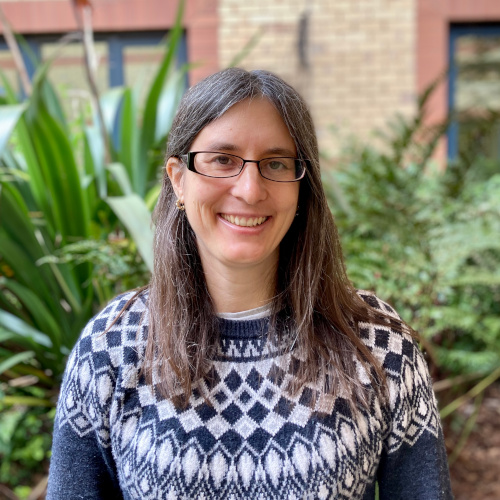
Charmaine Dean
More details
Several key collaboration portfolios are managed by her office, including the university-level Centres and Institutes and several major industrial partnerships spanning various units in the university. She has drawn a focus to ethics and social impact related to technology developments through various initiatives and is a key driver for equity and diversity in the context of research and internationalization. Prior to joining the University of Waterloo, Dr. Dean served as the Dean of Science at Western University from 2011 to 2017. She also played a major role in establishing the Faculty of Health Sciences at Simon Fraser University, as the Associate Dean of that Faculty, and was the founding Chair of the Department of Statistics and Actuarial Science at Simon Fraser University. Dr. Dean has been awarded numerous honours for her work including Fellowships with the Institute of Mathematical Statistics, the Fields Institute, the American Statistical Association, and the American Association for the Advancement of Science. In 2023, she was awarded the Statistical Society of Canada Gold Medal. In 2024, she was bestowed the rank of Chevalier in the prestigious Ordre des Palmes académiques by the French government for her work advancing research connections between Canada and France. Additionally, Dr. Dean has held several editorships and served in numerous leadership roles internationally and nationally, related to equity and inclusion, statistics and data science, research, and computing infrastructure. In Canada, she served as President of the Statistical Society of Canada and serves on several Boards of Directors. She is currently Chair of Council for NSERC (the Natural Sciences and Engineering Research Council of Canada).Optimizing research impact through interdisciplinary and collaborative research
Interdisciplinary collaborative research is a key component of data science and for some of us, plays an important part of our roles as statisticians. It is not unusual that we become accustomed to vertical thinking whereby we use existing tools and methods in our own specialty to problem solve, losing sight of the larger interdisciplinary context of data science, and the context of the scientific challenge. The Government of Canada - Science and Technology branch has identified several priority research challenge topics that involve cross-disciplinary work. Although statistical tools and analytics are identified in these research challenge priority areas, additionally, the development of fundamental transformative and enabling technological tools specifically for statistical methods and analytics to support research and societal advancement is also seen as a priority. This talk shares insights about the challenges and opportunities for statistics in interdisciplinary research. Specifically, monitoring viral signals in wastewater and assessing forest fire risk are given as complex, case studies that use a collaborative and interdisciplinary approach to solve difficult problems. This approach will demonstrate the significant benefits for not only optimizing research impact but for training students to become horizontal problem solvers across a wide range of research methods which will benefit them in navigating complex problems and in the development of appropriate tools for their analysis.

Charmaine Dean
More details
Several key collaboration portfolios are managed by her office, including the university-level Centres and Institutes and several major industrial partnerships spanning various units in the university. She has drawn a focus to ethics and social impact related to technology developments through various initiatives and is a key driver for equity and diversity in the context of research and internationalization. Prior to joining the University of Waterloo, Dr. Dean served as the Dean of Science at Western University from 2011 to 2017. She also played a major role in establishing the Faculty of Health Sciences at Simon Fraser University, as the Associate Dean of that Faculty, and was the founding Chair of the Department of Statistics and Actuarial Science at Simon Fraser University. Dr. Dean has been awarded numerous honours for her work including Fellowships with the Institute of Mathematical Statistics, the Fields Institute, the American Statistical Association, and the American Association for the Advancement of Science. In 2023, she was awarded the Statistical Society of Canada Gold Medal. In 2024, she was bestowed the rank of Chevalier in the prestigious Ordre des Palmes académiques by the French government for her work advancing research connections between Canada and France. Additionally, Dr. Dean has held several editorships and served in numerous leadership roles internationally and nationally, related to equity and inclusion, statistics and data science, research, and computing infrastructure. In Canada, she served as President of the Statistical Society of Canada and serves on several Boards of Directors. She is currently Chair of Council for NSERC (the Natural Sciences and Engineering Research Council of Canada).Optimizing research impact through interdisciplinary and collaborative research
Interdisciplinary collaborative research is a key component of data science and for some of us, plays an important part of our roles as statisticians. It is not unusual that we become accustomed to vertical thinking whereby we use existing tools and methods in our own specialty to problem solve, losing sight of the larger interdisciplinary context of data science, and the context of the scientific challenge. The Government of Canada - Science and Technology branch has identified several priority research challenge topics that involve cross-disciplinary work. Although statistical tools and analytics are identified in these research challenge priority areas, additionally, the development of fundamental transformative and enabling technological tools specifically for statistical methods and analytics to support research and societal advancement is also seen as a priority. This talk shares insights about the challenges and opportunities for statistics in interdisciplinary research. Specifically, monitoring viral signals in wastewater and assessing forest fire risk are given as complex, case studies that use a collaborative and interdisciplinary approach to solve difficult problems. This approach will demonstrate the significant benefits for not only optimizing research impact but for training students to become horizontal problem solvers across a wide range of research methods which will benefit them in navigating complex problems and in the development of appropriate tools for their analysis.

Cheng Soon Ong
Cheng Soon Ong is an Associate Science Director at Data61, CSIRO and a senior principal research scientist at the Statistical Machine Learning Group. He works on extending machine learning methods and enabling new approaches to scientific discovery, and has led the machine learning and artificial intelligence future science platform at CSIRO. He supervises and mentors many junior scientists, collaborates with scientists on problems in genomics and astronomy, advocates for open science, and is an adjunct Associate Professor at the Australian National University. He is co-author of the textbook Mathematics for Machine Learning, and his career has spanned multiple roles in Malaysia, Germany, Switzerland, and Australia.
On Finding Good Experiments
One of the key choices we have as scientists is to design informative experiments. With computational methods like AI promising accurate predictions, we revisit the question of adaptively designing new measurements that take previous data into account. Using examples from genomics, we illustrate some recent ideas on using machine learning to recommend experiments. Then we discuss potential impacts on choosing measurements in spatiotemporal problems. We conclude by outlining some opportunities and challenges of including machine learning in the scientific discovery process.

Cheng Soon Ong
Cheng Soon Ong is an Associate Science Director at Data61, CSIRO and a senior principal research scientist at the Statistical Machine Learning Group. He works on extending machine learning methods and enabling new approaches to scientific discovery, and has led the machine learning and artificial intelligence future science platform at CSIRO. He supervises and mentors many junior scientists, collaborates with scientists on problems in genomics and astronomy, advocates for open science, and is an adjunct Associate Professor at the Australian National University. He is co-author of the textbook Mathematics for Machine Learning, and his career has spanned multiple roles in Malaysia, Germany, Switzerland, and Australia.
On Finding Good Experiments
One of the key choices we have as scientists is to design informative experiments. With computational methods like AI promising accurate predictions, we revisit the question of adaptively designing new measurements that take previous data into account. Using examples from genomics, we illustrate some recent ideas on using machine learning to recommend experiments. Then we discuss potential impacts on choosing measurements in spatiotemporal problems. We conclude by outlining some opportunities and challenges of including machine learning in the scientific discovery process.

Heather Turner
Heather is an Associate Professor and EPSRC Research Software Engineering Fellow in the Statistics Department at the University of Warwick, UK. She has over 20 years of experience in the development of statistical code and software, gained through positions in academia, industry, and as a freelance consultant. In research, she has developed a portfolio of R packages for statistical modelling and collaborated on applications in sports, social science and agriculture. In her work with industry, she has specialised in applications in pharmaceutical R&D, with companies including Pfizer, Johnson & Johnson and Roche. Heather is active in community management and engagement among R users and developers. She is on the board of the R Foundation and chairs the R Contribution Working Group (fostering the community of contributors to the R project) and the R Forwards taskforce (widening the participation of under-represented groups in the R community).
Uses of gnm for Generalized (Non)linear Modelling
The R package {gnm} was designed as a unified interface to fit Generalized Nonlinear Models: generalized to handle responses with restricted range and/or a variance that depends on the mean, and nonlinear to allow the predictor for the mean to be nonlinear in its parameters. This framework covers several models that were proposed in the literature and adopted in practice before {gnm} was released, but used to require a mixed bag of specialised software to fit.
With {gnm} celebrating its 20th birthday this year, it’s a good time to review how the package is being used. I’ll highlight some of the applications we were aware of when {gnm} was first developed, that remain in common use, and explore more recent applications, particularly in the field of biometrics.
We’ll discover one motivation for using {gnm}, is for the ““eliminate”” feature that efficiently estimates stratification parameters. This can be useful even when the predictor is linear, as in the case of using conditional Poisson models to analyse case-crossover studies in epidemiology. We’ll also look at two of the packages that have built on {gnm}. The first, {multgee}, uses {gnm} to fit multiplicative interactions for certain correlation structures when modelling categorical data, with applications in public health, agriculture, and psychology. The second, {VFP}, is a more specialised package that uses {gnm} to model the mean-variance relationship for in-vitro diagnostic assays.
Through these use cases we’ll see how different features of {gnm} can be applied, demonstrating the versatility of this software.

Heather Turner
Heather is an Associate Professor and EPSRC Research Software Engineering Fellow in the Statistics Department at the University of Warwick, UK. She has over 20 years of experience in the development of statistical code and software, gained through positions in academia, industry, and as a freelance consultant. In research, she has developed a portfolio of R packages for statistical modelling and collaborated on applications in sports, social science and agriculture. In her work with industry, she has specialised in applications in pharmaceutical R&D, with companies including Pfizer, Johnson & Johnson and Roche. Heather is active in community management and engagement among R users and developers. She is on the board of the R Foundation and chairs the R Contribution Working Group (fostering the community of contributors to the R project) and the R Forwards taskforce (widening the participation of under-represented groups in the R community).
Uses of gnm for Generalized (Non)linear Modelling
The R package {gnm} was designed as a unified interface to fit Generalized Nonlinear Models: generalized to handle responses with restricted range and/or a variance that depends on the mean, and nonlinear to allow the predictor for the mean to be nonlinear in its parameters. This framework covers several models that were proposed in the literature and adopted in practice before {gnm} was released, but used to require a mixed bag of specialised software to fit.
With {gnm} celebrating its 20th birthday this year, it’s a good time to review how the package is being used. I’ll highlight some of the applications we were aware of when {gnm} was first developed, that remain in common use, and explore more recent applications, particularly in the field of biometrics.
We’ll discover one motivation for using {gnm}, is for the ““eliminate”” feature that efficiently estimates stratification parameters. This can be useful even when the predictor is linear, as in the case of using conditional Poisson models to analyse case-crossover studies in epidemiology. We’ll also look at two of the packages that have built on {gnm}. The first, {multgee}, uses {gnm} to fit multiplicative interactions for certain correlation structures when modelling categorical data, with applications in public health, agriculture, and psychology. The second, {VFP}, is a more specialised package that uses {gnm} to model the mean-variance relationship for in-vitro diagnostic assays.
Through these use cases we’ll see how different features of {gnm} can be applied, demonstrating the versatility of this software.

Jesse Goodman
Jesse Goodman is a Senior Lecturer in Statistics at the University of Auckland. He began his academic career in mathematical probability, using distributional approximations and large deviations techniques to understand random geometric structures, and increasingly looking at statistical models that exhibit probabilistic complexity. His research focuses on asymptotic techniques, particularly when several asymptotic effects interact or compete, in areas from branching processes and spatial structures to approximations for likelihoods and densities. Recent work on saddlepoint approximations has helped to quantify the degree to which approximation techniques can deliver valid inferential conclusiosn, and to extend classes of models to capture real-life complexity in capture-recapture and other settings that feature enigmatic sensor data.
Saddlepoint approximations for likelihoods
Classically, the saddlepoint approximation has been used as a systematic method for converting a known generating function into an approximation for an unknown density function. More recently, it has been used instead as an approximation to the likelihood function. In this viewpoint, it is the underlying data-generating process whose generating function is used, and the saddlepoint approximation can be maximized to compute an approximate saddlepoint MLE for given observed data. This talk will explain how the saddlepoint approximation can be interpreted with a statistical lens, including common features for those otherwise intractable models where we can compute a generating function but not a likelihood. Many of these models come from statistical ecology, including sitations where we gather population-wide observations only. In addition, the talk will describe a class of models having simple theoretical guarantees for the effect of using the saddlepoint MLE as a substitute for the unknown true MLE, and will demonstrate new tools to visualize the saddlepoint approximation intuitively, to simplify and automate the computation of saddlepoint MLEs, and to quantitatively assess the amount of approximation error introduced by using an approximate likelihood as a substitute for an intractable true likelihood.

Jesse Goodman
Jesse Goodman is a Senior Lecturer in Statistics at the University of Auckland. He began his academic career in mathematical probability, using distributional approximations and large deviations techniques to understand random geometric structures, and increasingly looking at statistical models that exhibit probabilistic complexity. His research focuses on asymptotic techniques, particularly when several asymptotic effects interact or compete, in areas from branching processes and spatial structures to approximations for likelihoods and densities. Recent work on saddlepoint approximations has helped to quantify the degree to which approximation techniques can deliver valid inferential conclusiosn, and to extend classes of models to capture real-life complexity in capture-recapture and other settings that feature enigmatic sensor data.
Saddlepoint approximations for likelihoods
Classically, the saddlepoint approximation has been used as a systematic method for converting a known generating function into an approximation for an unknown density function. More recently, it has been used instead as an approximation to the likelihood function. In this viewpoint, it is the underlying data-generating process whose generating function is used, and the saddlepoint approximation can be maximized to compute an approximate saddlepoint MLE for given observed data. This talk will explain how the saddlepoint approximation can be interpreted with a statistical lens, including common features for those otherwise intractable models where we can compute a generating function but not a likelihood. Many of these models come from statistical ecology, including sitations where we gather population-wide observations only. In addition, the talk will describe a class of models having simple theoretical guarantees for the effect of using the saddlepoint MLE as a substitute for the unknown true MLE, and will demonstrate new tools to visualize the saddlepoint approximation intuitively, to simplify and automate the computation of saddlepoint MLEs, and to quantitatively assess the amount of approximation error introduced by using an approximate likelihood as a substitute for an intractable true likelihood.

Mevin Hooten
Mevin Hooten is a Professor in Statistics and Data Sciences at The University of Texas at Austin. His research focuses on developing statistical methodology for ecological and environmental applications that involve spatial and spatio-temporal data. He is a Fellow of the American Statistical Association (ASA) and received the Distinguished Achievement Award from the ASA section on statistics and the environment. He has authored over 185 papers and 3 textbooks and serves as Associate Editor for Biometrics, Environmetrics, and JABES.
Modularizing Biometric Models Facilitates Multistage Computing
Bayesian modeling has become invaluable in biometrics. It allows us to formally consider unobserved processes while accommodating uncertainty about data collection and our understanding of biological and ecological mechanisms. Several excellent software packages are available for fitting Bayesian models to data and are being applied every day to analyze biometric data. These methods allow us to answer questions using data in ways that has never before been possible. The adoption of Bayesian methods has led to bigger models necessary to answer tough questions using large and varied data sets. Bigger models and data sets lead to computing bottlenecks. Fortunately, a solution to Bayesian computing roadblocks sits in plain sight. The structure of Bayesian models allows us to rearrange them so that we can perform computing in stages. We can break big models into pieces, fit them separately, and then recombine them in later computing stages. Recursive Bayesian approaches can save us time by leveraging the parallel architecture of modern computers. A modular perspective allows us to see Bayesian models in a way that facilitates multistage computing. I will demonstrate the procedure with a set of biometric examples. These include geostatistical models in marine science, capture-recapture models for abundance estimation, and spatial point process models for species distributions.

Mevin Hooten
Mevin Hooten is a Professor in Statistics and Data Sciences at The University of Texas at Austin. His research focuses on developing statistical methodology for ecological and environmental applications that involve spatial and spatio-temporal data. He is a Fellow of the American Statistical Association (ASA) and received the Distinguished Achievement Award from the ASA section on statistics and the environment. He has authored over 185 papers and 3 textbooks and serves as Associate Editor for Biometrics, Environmetrics, and JABES.
Modularizing Biometric Models Facilitates Multistage Computing
Bayesian modeling has become invaluable in biometrics. It allows us to formally consider unobserved processes while accommodating uncertainty about data collection and our understanding of biological and ecological mechanisms. Several excellent software packages are available for fitting Bayesian models to data and are being applied every day to analyze biometric data. These methods allow us to answer questions using data in ways that has never before been possible. The adoption of Bayesian methods has led to bigger models necessary to answer tough questions using large and varied data sets. Bigger models and data sets lead to computing bottlenecks. Fortunately, a solution to Bayesian computing roadblocks sits in plain sight. The structure of Bayesian models allows us to rearrange them so that we can perform computing in stages. We can break big models into pieces, fit them separately, and then recombine them in later computing stages. Recursive Bayesian approaches can save us time by leveraging the parallel architecture of modern computers. A modular perspective allows us to see Bayesian models in a way that facilitates multistage computing. I will demonstrate the procedure with a set of biometric examples. These include geostatistical models in marine science, capture-recapture models for abundance estimation, and spatial point process models for species distributions.